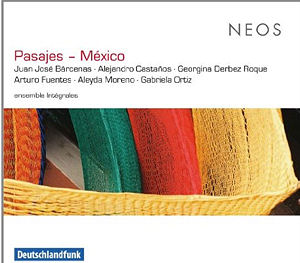 |
 |
| 

alternatively
CD: MDT
AmazonUK
AmazonUS
|
Pasajes - Mexico
Gabriela ORTIZ
(b. 1964) Trifolium (2005) for violin,
cello and piano
Arturo FUENTES (b. 1975) Lawine
(2009) for viola and pre-recorded CD
Alejandro CASTAÑOS
(b. 1978) Intersecciones for violin, alto
saxophone, percussion and electronics (2009) [12.19]
Georgina Derbez ROQUE (b. 1968)
Non piu infelice for violin, cello tenor saxophone and percussion
(2009) [10.26]
Aleydo MORENO
(b. 1982) Night Music for electric violin,
alto saxophone, piano and percussion, pre-recorded CD and live electronics
(2009) [16.10]
Juan José BÁRCENOS (b. 1982)
Un Rancor Vivo for electric violin, cello, tenor saxophone,
percussion and electronics [6.27]
 Ensemble Intégrales
Ensemble Intégrales
rec. 5-8 April 2009, Deutschlandfunk, Sensaal, Cologne
 NEOS 11047 [67.47]
NEOS 11047 [67.47] 
|
|
|
This CD consists of six compositions by six Mexican composers
each of whom is pictured within the attractive booklet. Six
members of Ensemble Intégrales are pictured on the cardboard
casing. So the presentation is pleasing and indeed quite lavish.
The notes on all of the pieces are rather brief. That may be
good or bad depending on your view, but for me a touch more
information about the music is, I feel, always helpful. But
what about the music? We’ll take the pieces in the order presented.
Gabriela Ortiz is in her late 30s and now lives in the USA.
Her Trifolium is for a conventional piano trio format.
This work is in a clear ternary form in which the ideas nicely
overlap and make a satisfactory structure. The essay says that
the composer draws upon the tonality and rhythm of “salon music”
in her native Mexico whilst “blending influences of the Western
avant-garde”. The outer sections are lively and exciting, the
inner, quiet and nocturnal, and a happy contrast, which works
well.
Arturo Fuentes studied with Ferneyhough and Donatoni. His Lawine
(Avalanche) inhabits a hinterland between what might be viola
sounds and electronic ones. The former are transformed electronically
as if in a diaologue with the pre-recorded CD. Apparently the
composer is “concerned with probing the spiritual and philosophical
dimensions” between computer music and philosophy. The frenetic
sound-world is indeed an avalanche of coruscating, scratching
and clamour and is curiously fascinating. At less than ten minutes
it makes its point with compact bravura.
In Alejandro Castaños’s Intersecciones there are, say
the notes, four protagonists. The violin, which has an extraordinary
cadenza at about nine minutes in, the cello and the saxophone.
The electronics, “with the wink of an eye” can alter the texture
and colour of a work which “juxtaposes static and sharply contrasted
blocks of sound”. Listen for instance to the violent opening
followed by the utterly still consequent minute or so. This
is a seriously avant-garde work with an element of modern jazz
and a witty allegro section in which vocal noises are inserted.
We have already noted how these young composers use Western
tradition to suit their own artistic aims. Georgina Roque, who
also studied with Donatoni, describes herself as a ‘musical
archaeologist’. She deliberately bases her work Non piu infelice
on a piece from the late 14th Century the period
of the ‘ars subtillior’ by the little known Paolo da Firenze.
At no point does the original really rear up in front of you
but occasional phrases seem to relate to medieval cadences and
melodic contours. It is gently appealing and even nostalgic
music with its use of saxophone and wispy percussion. I would
like to hear more of her work.
Juan José Bárcenos has worked mainly in the multi-media arts-world.
As a video artist he is a member of a group called “Colectivo
Kaoss” who work in experimental electronic music. His Un
Rencor Vivo (A lively rancour) attempts to “find musical
parallels for Paradise, hell and Purgatory as found in Juan
Rulfo’s novel Pedro Páramo, in which he sees a reflection of
present-day Mexican Society”. Sadly I can only detect Hell in
these wild, scrambled six and a bit minutes. If there was a
prize for the most unmusical experience of the year it could,
as far as I am concerned, be awarded to this piece. Let’s move
on to the last work. It’s the longest here.
Aleyda Moreno’s Night Music is for electronic violin,
alto sax, piano and percussion. She studied piano, composition
and electronic music in Mexico City and is a member of ‘Noiztrik’,
an improvisational group. This Night Music alludes possibly
to Bartók but one is reminded not only of animal murmurings
and the natural environment but also of how the darkness itself
is frightening and intimidating. Moreno flirts occasionally
with tonality as instrumental splashes of melody float across
the soundscape and then returns to an electronic smear. It’s
quite fascinating and brings the disc to an intriguing conclusion.
The Ensemble Intégrales are well known throughout Europe. Although
based in Germany they have been promoting new music from all
over the world in recent years. For example in 2007 they worked
with Asian composers. There is no doubt about their commitment,
expressive abilities and virtuosity. These composers are fortunate
indeed to have them working for them with such flair.
Gary Higginson
|
|

